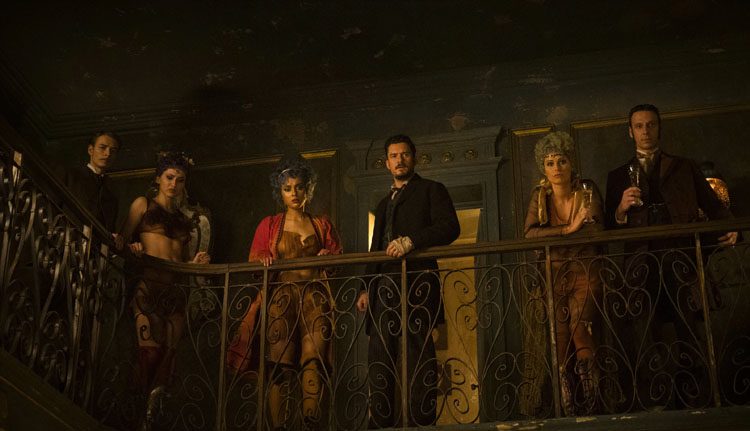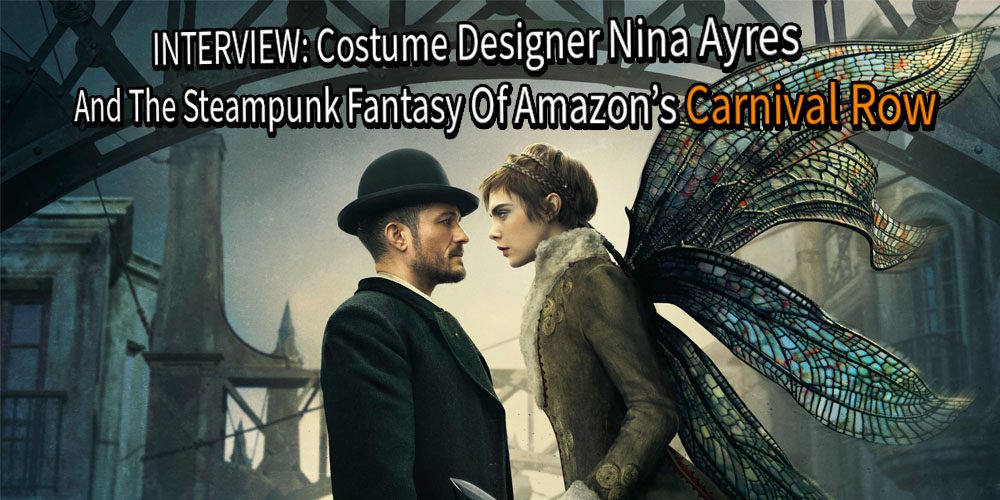Mythical creatures such as fairies have fled their war-torn homeland in the Amazon series Carnival Row starring Orlando Bloom and Cara Delevingne. Nina Ayres dressed the neo-noir fantasy for its final season.
Carnival Row exists in a gritty, Victorian-era world where reality and fantasy clash. Creatures from another world are trying to find a home in our world, leading to tension and new, dangerous alliances. Philo (Bloom) navigates it all as a detective. Vignette (Delevingne) is a faerie, and former lover of Philo caught in the fight to help her people find a place to exist. Through two seasons and 16 episodes, the pair face their feelings for each other while becoming lynchpins in a growing struggle between powerful factions.
PopAxiom spoke with Nina about her career and creating the unique look for the gritty fantasy series Carnival Row.
Transitioned
Nina’s interest in costumes began early in life. “I needed to learn every art or craft technique from a very young age, and as soon as my Nan taught me how to use her old, hand-operated Singer sewing machine, I was off.”
“From the age of seven or eight, I was making clothes for my dolls and stuffed toys, and even for myself,” she says, adding, “I can only imagine how disastrous they looked. Luckily my parents didn’t seem to care what I was wearing.”
Nana studied in the UK, where she had to choose two “non-academic” subjects. “I had to convince the school that I could not give up art, drama, or textiles, and somehow they agreed.”
“A teacher almost laughingly said I could be a costume designer,” she laughs, adding that it was a career “I had never heard of, and immediately I knew that was what I wanted to be.”
During her education, Nina put on some rather bizarre fashion shows. “I used our family oven to melt old records and crisp packets and inner tubes and old net curtains to make the garments.” But, Nina admits, “It was obvious that I was never going to become a fashion designer because my love of drama and characters was too immense.”
“I traveled for a while, as I felt I needed to gain some experience of the world,” she says of her time before attending London’s Central School of Speech and Drama, where she studied theatre design.” Nina loves “the process of learning.” She included set design, costume props, and puppetry in her studies there. “When I left, I worked for a costume prop company in between designing theatre shows.”
After about ten years and having published a book ‘Creating Outdoor Theatre’ via publisher Crowood Press, Nina transitioned to TV and film via the costume breakdown department. “Heading the breakdown department on Game of Thrones, I was asked to become assistant designer, which I did for around four years while assisting on other films and tv shows before working as a head designer on various shows.”

About Carnival Row
When a call came in, Nina was in Los Angeles for the Costume Designer Guild Awards and her nomination for Outlander. “My agent asked me to go for an interview with Legendary Productions while I was there as they needed a designer for Carnival Row.” Nina met with series writer Travis Beecham and showrunner Marc Guggenheim. “We got along rather well, so off I went to Prague.”
“It was centered around how long it had been since the final events of season 1,” she says about her first discussion with the creative team about the show. “What had been happening to the characters and their world in general.”
The creative team wanted “continuity for certain characters,” she explains, “especially those whose situation hadn’t changed much since season 1, and where the characters that were in different situations were headed.”
“Juri Matura, the production designer, and I worked hard on creating a new aesthetic for the Row which would show imprisonment as well as a sense of dignity, a level of wear and tear but with a solidarity and desire to not live in squalor.” In fact, season two ups the detail in every shot, making an already visually appealing show even more interesting to watch. “We discussed the new creatures to be introduced, such as the Kallos and the Elfin Mauro, and delved into their personalities and strengths, and I began designing them along with Nick Dudman, the MUFX designer.”
After becoming part of a project, Nina immerses herself “in the script and find out as much as I can about each character and the paths on which they are headed. In this case, that involved also writing to all the actors which were returning to find out about any particular wants or needs or previous issues they might have had I should be aware of.”
“I then begin fabric sampling and researching the era,” she explains step two, “or further afield, to begin the designs. Typically, I begin with mood boards for each group of characters. Before beginning specific costume designs, this includes silhouettes, color, texture, jewelry, etc..”
VFX and Costumes
What’s the interplay between VFX and costumes? “The majority of cases, it affects the practical side of a costume more than the visual side. Each time one reads of a wound or blood splattering in a script, the first question is, ‘practical blood or VFX blood’? Many factors play into the decision, but generally, in costume, we love it when, on rare occasions, the answer is VFX. This implies we don’t need to make at least 4 or 5 repeats of the same costume to allow for shooting the scene.
“Todd Shifflett, the VFX supervisor, and I had many discussions early on about his requirements for the faerie’s wings,” she adds. “These were sometimes practical and at times needed to move, so therefore VFX. We had to be careful not to have any costume covering the part where the wings attach to the body.”
Carnival Row is full of fantastical characters. “The centaurs or the kobolds, which involve VFX, still required the costumes to be made and fitted so that they are body scanned and a proper representation of the chosen fabrics, colors, and fit is achieved.” Other characters that were largely VFX “still required two or three versions of their costumes and a thorough knowledge of how and where the action occurs on the body to be able to shoot a ‘before,’ ‘after’ and ‘mid occurrence’ that Todd’s team could work from.”
Unique Challenges
“One of the unique challenges with Carnival Row was the many shifts in the direction it took,” she says after working on other costume-heavy shows like Outlander and The Last Kingdom. “Due to COVID and other factors, we encountered halts in filming, which resulted in changes that affected the character’s storylines. As a result, we had to be ultra vigilant about continuity in the costume department, with a ‘through’ line for the costume journeys.
Because of these stops and starts in filming, seasons changed. “We spent a lot of time trying to keep actors warm in ‘summer clothing’ while the actual temperature dropped, and cooler in their winter clothing as we were suddenly picking up scenes during an August heatwave.”
“The most fun and challenging part about Carnival Row is all the creatures,” she declares. “The inability to hire any of these costumes from hire houses meant the pressure on our workroom and resources was immense. After the quantities of the various creatures had been designed, made, and fitted to the individual cast or crowd, the same had to be done to each species in the warmer climate of Ragusa’s free New Dawn population. Then, each species dressed as a New Dawn soldier, then on the Row but in happier times. It all amounted to huge amounts of new designs and makes.”
The shows Nina works on tend to require a lot of breakdowns and repeats for stunt action. “ But this season of Carnival Row’s scale of destruction was very challenging. Certain outfits required up to 8 repeats in various stages of breakdown as events left their mark on them, and others needed repeats to reshoot a scene a number of times with practical damage occurring. There seemed to be an unusually high number of these situations, which at the time was demanding, but was imperative to creating the beautifully gritty world the show inhabits.”
Wrapping Up
“A big one is directors wanting period costumes to ‘fall off’ in a nanosecond, or a character
getting dressed without assistance in period costume just as quickly,” she says about her least favorite request. “I dislike clothes being ripped off characters, as this is unrealistic, and it’s tough to pull on an invariably well-made period garment, then make it tear away.
Nina’s also not a fan of new clothes appearing out of nowhere. “I’m always so fully involved with each character’s narrative and the world around them that I like some logic to a change of clothes. I’m always asking myself, ‘where did they find them?.’” She fully understands the need for dramatic action, “and I am desperate for the ability to have an actor wear the fabulous new outfit I have designed, but I’m so immersed in the characters and story that I either have to wait or suggest a way of making it happen.”
“My favorite things are just good design,” she states. “I love it when a design tells a story and has a history and subtle, nuanced imagery or suggestion. I love it when I notice some motif or flash of color which reveals an emerging allegiance. It’s storytelling through design decisions that absolutely enthralls me.” She’s also a fan of something readers might not expect. “I also love it when a costume is destroyed, and the designer takes that outfit on a journey. The interest in how one garment can evolve and breakdown fascinates me, and I love to see that played out.”
How does Nina recharge her creative batteries? “While in Prague working on Carnival Row, I rescued a beautiful little dog, so I go for many fabulous walks and runs in the countryside or on the beach with her.”
“There are so many things,” she answers when asked about projects she has yet to do. “I’d love to design something set in the future or, indeed, the recent past so that I get to play with ideas of modern dress and explore the way people wear garments now. I’m fascinated by modern tech but rarely use it in my current designs.”
What’s coming next that Nina can talk about? “There’s a couple of projects in the mix but nothing I can speak of just yet.”
Is Carnival Row on your watch list?
Thanks to Nina Ayres and Impact24 PR
for making this interview possible.
Find more interviews from Ruben R. Diaz!


